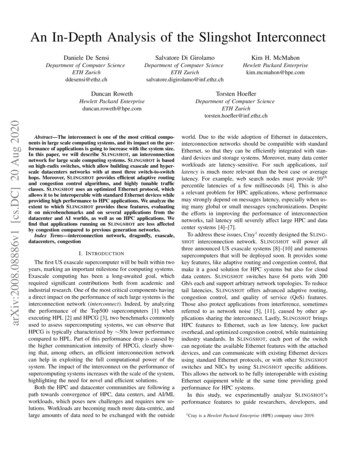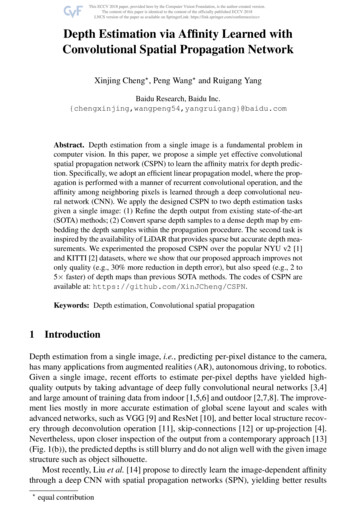
Transcription
arXiv:2008.08886v1 [cs.DC] 20 Aug 2020An In-Depth Analysis of the Slingshot InterconnectDaniele De SensiSalvatore Di GirolamoKim H. McMahonDepartment of Computer ScienceETH Zurichddesensi@ethz.chDepartment of Computer ScienceETH Zurichsalvatore.digirolamo@inf.ethz.chHewlett Packard Enterprisekim.mcmahon@hpe.comDuncan RowethTorsten HoeflerHewlett Packard Enterpriseduncan.roweth@hpe.comDepartment of Computer ScienceETH Zurichtorsten.hoefler@inf.ethz.chAbstract—The interconnect is one of the most critical components in large scale computing systems, and its impact on the performance of applications is going to increase with the system size.In this paper, we will describe S LINGSHOT, an interconnectionnetwork for large scale computing systems. S LINGSHOT is basedon high-radix switches, which allow building exascale and hyperscale datacenters networks with at most three switch-to-switchhops. Moreover, S LINGSHOT provides efficient adaptive routingand congestion control algorithms, and highly tunable trafficclasses. S LINGSHOT uses an optimized Ethernet protocol, whichallows it to be interoperable with standard Ethernet devices whileproviding high performance to HPC applications. We analyze theextent to which S LINGSHOT provides these features, evaluatingit on microbenchmarks and on several applications from thedatacenter and AI worlds, as well as on HPC applications. Wefind that applications running on S LINGSHOT are less affectedby congestion compared to previous generation networks.Index Terms—interconnection network, dragonfly, exascale,datacenters, congestionI. I NTRODUCTIONThe first US exascale supercomputer will be built within twoyears, marking an important milestone for computing systems.Exascale computing has been a long-awaited goal, whichrequired significant contributions both from academic andindustrial research. One of the most critical components havinga direct impact on the performance of such large systems is theinterconnection network (interconnect). Indeed, by analyzingthe performance of the Top500 supercomputers [1] whenexecuting HPL [2] and HPCG [3], two benchmarks commonlyused to assess supercomputing systems, we can observe thatHPCG is typically characterized by 50x lower performancecompared to HPL. Part of this performance drop is caused bythe higher communication intensity of HPCG, clearly showing that, among others, an efficient interconnection networkcan help in exploiting the full computational power of thesystem. The impact of the interconnect on the performance ofsupercomputing systems increases with the scale of the system,highlighting the need for novel and efficient solutions.Both the HPC and datacenter communities are following apath towards convergence of HPC, data centers, and AI/MLworkloads, which poses new challenges and requires new solutions. Workloads are becoming much more data-centric, andlarge amounts of data need to be exchanged with the outsideworld. Due to the wide adoption of Ethernet in datacenters,interconnection networks should be compatible with standardEthernet, so that they can be efficiently integrated with standard devices and storage systems. Moreover, many data centerworkloads are latency-sensitive. For such applications, taillatency is much more relevant than the best case or averagelatency. For example, web search nodes must provide 99thpercentile latencies of a few milliseconds [4]. This is alsoa relevant problem for HPC applications, whose performancemay strongly depend on messages latency, especially when using many global or small messages synchronizations. Despitethe efforts in improving the performance of interconnectionnetworks, tail latency still severely affect large HPC and datacenter systems [4]–[7].To address these issues, Cray1 recently designed the S LING SHOT interconnection network. S LINGSHOT will power allthree announced US exascale systems [8]–[10] and numeroussupercomputers that will be deployed soon. It provides somekey features, like adaptive routing and congestion control, thatmake it a good solution for HPC systems but also for clouddata centers. S LINGSHOT switches have 64 ports with 200Gb/s each and support arbitrary network topologies. To reducetail latencies, S LINGSHOT offers advanced adaptive routing,congestion control, and quality of service (QoS) features.Those also protect applications from interference, sometimesreferred to as network noise [5], [11], caused by other applications sharing the interconnect. Lastly, S LINGSHOT bringsHPC features to Ethernet, such as low latency, low packetoverhead, and optimized congestion control, while maintainingindustry standards. In S LINGSHOT, each port of the switchcan negotiate the available Ethernet features with the attacheddevices, and can communicate with existing Ethernet devicesusing standard Ethernet protocols, or with other S LINGSHOTswitches and NICs by using S LINGSHOT specific additions.This allows the network to be fully interoperable with existingEthernet equipment while at the same time providing goodperformance for HPC systems.In this study, we experimentally analyze S LINGSHOT’sperformance features to guide researchers, developers, and1 Crayis a Hewlett Packard Enterprise (HPE) company since 2019.
in the picture, and then down a column channel to Port 56.Thanks to the hierarchical structure of the tiles, there is noneed for a 64 ports arbiter, and the packets only incur in a 16to 8 arbitration.14 150001161732334849RowBusses2 200Gb/s Ethernet NICs were not available at the time of 3585912132829444560611415303146476263Tile16 row buses(1 per port)14/1546/4762/63.From other tiles16:8xbarColumn crossbarsPort numbersPort 3114/1546/4762/63Fig. 1: ROSETTA switch tiled structure.The 32 tiles in ROSETTA implement a crossbar between the64 ports. For performance and implementation reasons, thecrossbar is physically composed by different function-specificcrossbars, each handling a different aspect of the switchingtraffic: A. Switch Technology (ROSETTA)The core of the S LINGSHOT interconnect is the ROSETTAswitch, providing 64 ports at 200 Gb/s per direction. Each portuses four lanes of 56 Gb/s Serializer/Deserializer (SerDes)blocks using Pulse-Amplitude Modulation (PAM-4) modulation. Due to Forward Error Correction (FEC) overhead,50Gb/s can be pushed through each lane. The ROSETTA ASICconsumes up to 250 Watts and is implemented on TSMCs 16nm process. ROSETTA is composed by 32 peripheral functionblocks and 32 tile blocks. The peripheral blocks implementthe SerDes, Medium Access Control (MAC), Physical CodingSublayer (PCS), Link Layer Reliability (LLR), and Ethernetlookup functions.The 32 tile blocks implement the crossbar switching between the 64 ports, but also adaptive routing and congestionmanagement functionalities. The tiles are arranged in fourrows of eight tiles, with two switch ports handled per tile, asshown in Figure 1. The tiles on the same row are connectedthrough 16 per-row buses, whereas the tiles on the samecolumn are connected through dedicated channels with pertile crossbars. Each row bus is used to send data from thecorresponding port to the other 16 ports on the row. The pertile crossbar has 16 inputs (i.e., from the 16 ports on the row)and 8 outputs (i.e., to the 8 ports on the column). For each port,a multiplexer is used to select one of the four inputs (this is notexplicitly shown in the figure for the sake of clarity). Packetsare routed to the destination tile through two hops maximum.Figure 1 shows an example: if a packet is received on Port 19and must be routed to Port 56, the packet is first routed on therow bus, then it goes through the 16-to-8 crossbar highlighted040520213637525346 47 62 63II. S LINGSHOT A RCHITECTUREWe now describe the S LINGSHOT interconnection network.We first introduce the ROSETTA switch and show how switchescan be connected to form a Dragonfly [12] topology. We thendive into specific features of S LINGSHOT such as adaptiverouting, congestion control, and quality of service management. Lastly, we describe the main characteristics of theS LINGSHOT additions to Ethernet and the software stack.0203181934355051To other portsPort 30.Rosetta Switch.system administrators. We use Mellanox ConnectX-5 100 Gb/sEthernet NICs to test the ability of S LINGSHOT to deal withstandard RDMA over Converged Ethernet (RoCE) traffic2 .Moreover, by doing so we can analyze the impact of the switchon the end-to-end performance by factoring out some of theimprovements on the Ethernet protocol introduced by S LING SHOT . We first analyze the latencies of a quiet system. Then,we analyze the impact of congestion on both microbenchmarksand real applications for different configurations, showing thatS LINGSHOT is only marginally affected by network noise. Tofurther show the benefits of the congestion control algorithm,we compare S LINGSHOT to Cray’s previous A RIES network,which has a similar topology and uses a similar routingalgorithm. Requests to Transmit To avoid head-of-line blocking(HOL) [13], ROSETTA relies on a virtual output-queuedarchitecture [14], [15] where the routing path is determined before sending the data. The data is bufferedin the input buffers until the resources are available,guaranteeing no further blocks. Before forwarding thedata, a request-to-transmit is sent to the tile correspondingto the switch output port. When a grant to transmit isreceived from the output port, the data is forwarded.Grants to Transmit Grants to transmit are sent by thetile handling the output port to the tile from which theswitch received the packet. In the previous example, thegrants would be transmitted from the tile handling Port56, to the tile handling Port 19. Grants are used to notifythe permission to forward the data to the next hop. Theuse of requests and grants to transmit is a central pieceof the QoS management.Data Data is sent on a wider crossbar (48B). To speed upthe processing, ROSETTA parses and processes the packetheader as soon as it arrives, even if the data might stillbe arriving.Request Queue Credits Credits provide an estimation ofqueue occupancy. This information is then used by theadaptive routing algorithm (see Section II-C) to estimatethe congestion of different paths and to select the leastcongested one.End-to-End Acks End-to-End acknowledgments areused to track the outstanding packets between every pairof network endpoints. This information is used by thecongestion control protocol (see Section II-D).By using physically separated crossbars, S LINGSHOT guarantees that different types of messages do not interfere witheach other and that, for example, large data transfers do notslow down requests and grants to transmit.
300400500600Time (ns)Fig. 2: Distribution of switch latency for RoCE traffic.To analyze the impact of the switch architecture on thelatency, we report in Figure 2 the latency of the switchwhen dealing with RoCE traffic. It is worth remarking that,because we are using standard RoCE NICs, the NIC sendsplain Ethernet frames, and we cannot exploit all the featuresof S LINGSHOT’s specialized Ethernet protocol (Section II-F).Some of the features like link-level reliability and propagationof congestion information are however still used in the switchto-switch communications. To compute the latency of theswitch, we consider the latency difference between 2-hopsand 1-hop latencies (we provide details on the topology inSection II-B). We observe that ROSETTA has a mean andmedian latency of 350 nanoseconds, with all the distributionlying between 300 and 400 nanoseconds, except for a fewoutliers.B. TopologyROSETTA switches can be arranged into any arbitrary topology. Dragonfly [12] is the default topology for S LINGSHOTbased systems, and it is the topology we refer to in therest of the paper. Dragonfly is a hierarchical direct topology,where all the switches are connected to both computing nodesand other switches. Sets of switches are connected betweeneach other forming so-called groups. The switches insideeach group may be connected by using an arbitrary topology,and groups are connected in a fully connected graph. In theS LINGSHOT implementation of Dragonfly (shown in Figure 3),each ROSETTA switch is connected to 16 endpoints throughcopper cables (up to 2.6 meters), using the remaining 48 portsfor inter-switches connectivity. The partitioning of these 48ports between inter- and intra-group connectivity, as well asthe number of switches per group, depends on the size of thesystem. In S LINGSHOT, the switches inside a group are alwaysfully connected through copper cables. Switches in differentgroups are connected through long optical cables (up to 100meters). Due to the full-connectivity both within the group andbetween groups, this topology has a diameter of 3 switch-toswitch hops.Thanks to the low-diameter, applications performance onlymarginally depend on the specific node allocation. We reportin Figure 4 the latency and the bandwidth between nodesat different distances, and for different message sizes onan isolated system. We consider nodes connected to portson the same switch (1 inter-switch hop), connected to twodifferent switches in the same group (2 inter-switch hops), andconnected to two different switches in two different groups (3.N0N15.N496S1740831links16linksN511.N278238.544 global links17linksAll-to-All31withinlinksgroupGroup 544N278543.N27902417linksS1743916links.N279039Fig. 3: S LINGSHOT Topology. In this specific example weshow the topology of the largest 1-dimensional Dragonflynetwork that can be built with the 64-ports ROSETTA switches.Same switch2.8Time (us)200.1717linkslinksAll-to-AllSS3131within0 linkslinks 31group1616Group 0linkslinks.100.544 global links.0.005.Bandwidth (Gb/s)0.0100.000All-to-all amongst groupsMeanMedian1st Percentile99th Percentile.0.015Different switchesDifferent B4MiBFig. 4: Latency and bandwidth for different node distances,on an isolated system. Q1 is the first quartile, Q3 is the thirdquartile, IQR Q3 Q1, S is the smallest sample greaterthan Q1 1.5 · IQR, and L is the largest sample smaller thanQ3 1.5 · IQR.inter-switch hops). For the same switch case, we observed nosignificant difference when using two ports on the same switchtile or on two different tiles.First, we observe that, in the worst case, the node allocationhas only a 40% impact on the latency for 8B messages andthat, starting from 16KiB messages we observe less than 10%difference in latency between the different node distances.The same holds for bandwidth, with less than 15% differencebetween the different distances across all the message sizes. Insome cases, we observe a slightly higher bandwidth when thenodes are in two different groups, because more paths connectthe two nodes, increasing the available bandwidth.In the largest system (shown in Figure 3), each group has32 switches (for a total of 32 16 512 nodes, and switchesinside each group are fully connected by using 31 switchesports. The remaining 17 ports from each switch are used toglobally connect all the groups in a fully connected network.In this specific case, because each group contains 32 switchesand each switch uses 17 ports to connect to other groups, eachgroup has 32 17 544 connection towards other groups.This leads to a system having 545 groups, each of which isconnected to 512 nodes, for a total of 279 040 endpoints at fullglobal bandwidth3 . This number of endpoints satisfies both3 In practice, the addressing scheme limits the number of groups to 511, fora total of 261 632 nodes.
exascale supercomputers and hyperscale data centers demand.Indeed, this is larger than the number of servers used in datacenters [16], and much larger than the number of nodes usedby Summit [17], the most performing supercomputer at thetime being, that currently relies on 4 608 nodes and delivers200P F lop/s. Thanks to this large number of endpoints, eachcomputing node can have multiple connections to the samenetwork, increasing the injection bandwidth and improvingnetwork resiliency in case of NICs failures.C. RoutingIn Dragonfly networks (including S LINGSHOT), any pairof nodes is connected by multiple minimal and non-minimalpaths [12], [18]. For example, by considering the topology inFigure 3, the minimal path connecting N0 to N496 includesthe switches S0 and S31. In smaller networks, due to linksredundancy,multiple minimal paths are connecting any pairof nodes [18]. On the other hand, a possible non-minimalpath involves an intermediate switch that is directly connectedto both S0 and S31. The same holds for nodes located indifferent groups. In this case, a non-minimal path crosses anintermediate group.Sending data on minimal paths is clearly the best choiceon a quiet network. However, in a congested network, withmultiple active jobs, those paths may be slower than longerbut less congested ones. To provide the highest throughputand lowest latency, S LINGSHOT implements adaptive routing:before sending a packet, the source switch estimates the loadof up to four minimal and non-minimal paths and sends thepacket on the best path, that is selected by considering both thepaths’ congestion and length. The congestion is estimated byconsidering the total depth of the request queues of each outputport. This congestion information is distributed on the chip byusing a ring to all the forwarding blocks of each input port. It isalso communicated between neighboring switches by carryingit in the acknowledgement packets. The total overhead forcongestion and load information is an average of four bytes inthe reverse direction for every packet in the forward direction.As more packets take non-minimal paths and therefore averagehop count per packet increases, both the latency and the linkutilization increase. Therefore, S LINGSHOT adaptive routingbiases packets to take minimal paths more frequently, tocompensate for the higher cost of non-minimal paths.D. Congestion ControlTwo types of congestion might affect an interconnection network: endpoint congestion, and intermediate congestion [6]. The endpoint congestion mostly occurs on the lasthop switches, whereas intermediate congestion is spread acrossthe network. Adaptive routing improves network utilizationand application performance by changing the path of thepackets to avoid intermediate congestion. However, even ifadaptive routing can bypass congested intermediate switches,all the paths between two nodes are affected in the same wayby endpoint congestion. As we show in Section III-A, thiswas a relevant issue on other networks, particularly for manyto-one traffic. In this case, due to the highly congested linkson the receiver side, the adaptive routing would spread thepackets over the different paths but without being able to avoidcongestion, because it is occurring in the last hop.Congestion control helps in mitigating this problem bydecreasing the injection bandwidth of the nodes generating thecongestion. However, existing congestion control mechanisms(like ECN [19] and QCN [20], [21]) are not suited for HPCscenarios. They work by marking packets that experiencecongestion. When a node receives a packet that has beenmarked, it asks the sender to slow down its injection rate.These congestion control algorithms work relatively well inpresence of large volume and stable communications (knownas elephant flows), but tend to be fragile, hard to tune [22],[23], and generally unsuitable for bursty HPC workloads.Indeed, in standard congestion control algorithms, the controlloop is too long to adapt fast enough, and while convergingto the correct transmission rate, the offending traffic can stillinterfere with other applications.To mitigate this problem, S LINGSHOT introduces a sophisticated congestion control algorithm, entirely implemented inhardware, that tracks every in-flight packet between everypair of endpoints in the system. S LINGSHOT can distinguishbetween jobs that are victims of congestion and those whoare contributing to congestion, applying stiff and fast backpressure to the sources that are contributing to congestion. Bytracking all the endpoints pairs individually, S LINGSHOT onlythrottles those streams of packets who are contributing to theendpoint congestion, without negatively affecting other jobsor other streams of packets within the same job who are notcontributing to congestion. This frees up buffers space for theother jobs, avoiding HOL blocking across the entire network,and reducing tail latencies, which are particularly relevant forapplications characterized by global synchronizations.The approach to congestion control adopted by S LINGSHOTis fundamentally different from more traditional approachessuch as ECN-based congestion control [19], [20], and leads togood performance isolation between different applications, aswe show in Section III-A.E. Quality of Service (QoS)Whereas congestion control partially protects jobs frommutual interference, jobs can still interfere with each other.To provide complete isolation, in S LINGSHOT jobs can beassigned to different traffic classes, with guaranteed quality ofservice. QoS and congestion control are orthogonal concepts.Indeed, because traffic classes are expensive resources requiring large amounts of switch buffers space, each traffic classis typically shared among several applications, and congestioncontrol still needs to be applied within a traffic class.Each traffic class is highly tunable and can be customizedby the system administrator in terms of priority, packetsordering required, minimum bandwidth guarantees, maximumbandwidth constraint, lossiness, and routing bias [5]. Thesystem administrator guarantees that the sum of the minimum
F. Ethernet EnhancementsTo improve interoperability, and to better suit datacentersscenarios, S LINGSHOT is fully Ethernet compatible, and canseamlessly be connected to third-party Ethernet-based devicesand networks. S LINGSHOT provides additional features on topof standard Ethernet, improving its performance and makingit more suitable for HPC workloads. S LINGSHOT uses thisenhanced protocol for internal traffic, but it can mix it withstandard Ethernet traffic on all ports at packet-level granularity.This allows S LINGSHOT to achieve high-performance, whileat the same time being able to communicate with standardEthernet devices, allowing it to be used efficiently in bothsupercomputing and datacenter worlds.To improve performance, S LINGSHOT reduces the 64 Bytesminimum frame size to 32 Bytes, allows IP packets to besent without an Ethernet header, and removes the inter-packetgap. Lastly, S LINGSHOT provides resiliency at different levels by implementing low-latency Forward Error Correction(FEC) [25], Link-Level Reliability (LLR) to tolerate transient errors, and lanes degrade [26] to tolerate hard failures.Moreover, the S LINGSHOT NIC provides end-to-end retry toprotect against packet loss. These are relevant features in highperformance networks. For example, FEC is required for allEthernet systems at 100Gb/s or higher, independently fromthe system size, and LLR is useful in large systems (suchas hyperscale data centers) to localize the error handling andreduce end-to-end retransmission.G. Software StackCommunication libraries can either use the standard TCP/IPstack or, in case of high-performance communication li-braries such as MPI [27], [28], Chapel [29], PGAS [30] andSHMEM [31], the libfabric interface [32]. Cray contributedwith new features to the libfabric open-source verbs providerand RxM utility provider to support the S LINGSHOT hardware. All HPC traffic is layered over RDMA over ConvergedEthernet (RoCEv2) and data is sent over the network throughpackets containing up to 4KiB of data plus headers and trailers.Headers and trailers include Ethernet (26 bytes including thepreamble), IPv4 (20 bytes), UDP (8 bytes), InfiniBand (14bytes), and an additional RoCEv2 CRC (4 bytes), for a totalof 62 bytes. Cray MPI is derived from MPICH [33] andimplements the MPI-3.1 standard. Proprietary optimizationsand other enhancements have been added to Cray MPI targetedspecifically for the S LINGSHOT hardware. Any MPI implementation supporting libfabric can be used out of the box onS LINGSHOT. Moreover, standard API for some features, liketraffic classes, have been recently added to libfabric and couldbe exploited as well. We report in Figure 5 the latencies fordifferent message sizes and for different network protocols.We observe that for small message sizes, MPI adds only amarginal overhead to libfabric.IB VerbsLibfabric103RTT/2 (usec)bandwidth requirements of the different traffic classes doesnot exceed the available bandwidth. Network traffic can beassigned to traffic classes on a per-packet basis. The jobscheduler will assign to each job a small number of trafficclasses, and the user can then select on which class to sendits application traffic. In the case of MPI, this is done byspecifying the traffic class identifier in an environment variable. Moreover, communication libraries could even changetraffic classes at a per-message (or per-packet) granularity. Forexample, MPI could assign different collective operations todifferent traffic classes. For example, it may assign latencysensitive collective operations such as MPI Barrier andMPI Allreduce to high-priority and low-bandwidth trafficclasses, and bulk point-to-point operations to higher bandwidthand lower priority classes.Traffic classes are completely implemented in the switchhardware. A switch determines the traffic class required for aspecific packet by using the Differentiated Services Code Point(DSCP) tag in the packet header [24]. Based on the value of thetag, the switch assigns the packet to one of the multiple virtualqueues. Each switch will allocate enough buffers to each trafficclass to achieve the desired bandwidth, whereas the remainingbuffers will be dynamically allocated to the traffic which isnot assigned to any specific traffic bfabricTCPUDPIB Verbs85121024OSIPNIC driver101HWRoCEv2 NIC100101103105107Size (Bytes)Fig. 5: Half round trip time (RTT/2) for different messagesizes (x-axis) and software layers.Moreover, we show in Figure 6 the bisection bandwidth (i.e.,the bandwidth when half of the nodes send data to the otherhalf of the nodes and vice versa) and the MPI Alltoallbandwidth on S HANDY, a S LINGSHOT-based system using1 024 nodes (see Section III for details). We report the resultsfor different processes per node (PPN) and different messagesizes. This system is composed of eight groups, and all thebisection cuts cross the same number of links. In this system,each group has 56 global links out of 112 (8 towards eachother group), to match the injection bandwidth. Each of the 4groups in one partition is connected to each of the 4 groupsin the other partition, and the total number of links crossing abisection cut is 4·4·8 128. Because each link has a 200Gb/sbandwidth, and we are sending traffic in both directions, thepeak bisection bandwidth is 128 · 200Gb/s · 2 6.4T b/s.In an all-to-all communication, each node sends 7/8 ofthe traffic to nodes in the other 7 groups and 1/8 of thetraffic to nodes in the same group. Because this system has56·8 448 global links, the all-to-all maximum bandwidth is8/7 · 448 · 200Gb/s 12.8T b/s. Note that MPI Alltoallcan achieve twice the bisection bandwidth because half ofthe connections terminate in the same partition [34]. The plotshows that the MPI Alltoall reaches more than the 90%
14Theoretical Alltoall Bandwidth12Dragonfly group,x16 Rosetta switchesTB/s108G06G1G2G3G4G5G6G7Theoretical Bisection Bandwidth4Alltoall (PPN 16)Alltoall (PPN 24)Bisection (PPN 128)2128KiBKiB328KiB2KiB2B518B12B328B0SizeFig. 6: Bisection and MPI Alltoall bandwidth on all the1 024 nodes of S HANDY, for different processes per node(PPN) and message sizes. The x-axis is in logarithmic scale.of the theoretical peak bandwidth, without any packet loss. Weobserve a performance drop for 256 bytes messages because,to reduce memory usage, the MPI implementation switches toa different algorithm [35] for messages larger than 256 bytes.III. P ERFORMANCE S TUDYWe now study the performance of the S LINGSHOT interconnect on real applications and microbenchmarks, by focusingon two key features of S LINGSHOT, namely congestion controland quality of service management. For our analysis, weconsider the following systems: C RYSTAL : A system based on the Cray A RIES interconnect [48]. This system has 698 nodes. The CPUs on thenodes are Intel Xeon E5-269x. The system is composedof two groups, each containing at most 384 nodes. M ALBEC : A S LINGSHOT system with 484 nodes. CPUson the nodes are either Intel Xeon Gold 61xx or Intel XeonPlatinum 81xx CPUs. The system is composed of fourgroups, each containing at most 128 nodes. Each groupis connected to each other group through 48 global linksoperating at 200Gb/s each. Each node has a MellanoxConnectX-5 EN NIC. S HANDY : A S LINGSHOT system with 1024 nodes. Compute nodes are equipped with AMD EPYC Rome 64 coresCPUs. The system is composed of eight groups, eachcontaining 128 nodes. Each group is connected to eachother group through 56 global links operating at 200Gb/seach. Each node has two Mellanox ConnectX-5 EN NICs,each connected to a different switch of the same network,allowing a better load distribution and resilience in theevent of NICs failures.We consider two S LINGSHOT systems, of different size, toanalyze the performance at different system scales. For all theexperiments, we booked these systems for exclusive use, tohave a controlled environment and avoid interference causedby other users.nodes and aggressor nodes. The aggressor nodes generatecongestion that im
on high-radix switches, which allow building exascale and hyper-scale datacenters networks with at most three switch-to-switch hops. Moreover, SLINGSHOT provides efficient adaptive routing and congestion control algorithms, and highly tunable traffic classes. SLINGSHOT uses an optimized Ethernet protocol, which











